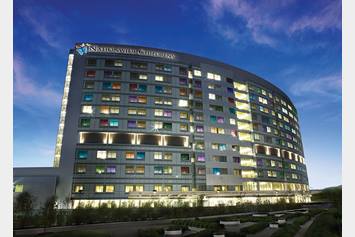Abdominal / Duplication Cysts
Abdominal cyst is a general term used to describe a rare, congenital birth defect that causes an irregular mass of tissue to grow in your baby’s abdomen.
What Are Abdominal Cysts?
Abdominal cyst is a general term used to describe a rare, congenital (happening before birth) birth defect that causes an irregular mass of tissue to grow in your baby’s abdomen (see pictures below). Cysts can range in size, location and severity, and cause a variety of symptoms. This can make them very hard to detect and diagnose. Growths can appear anywhere along the gastrointestinal tract or reproductive organs like the ovaries.
Sometimes in the gastrointestinal tract, the cysts appear to duplicate (copy) the cells and structures of the organs they are attached to. For this reason, gastrointestinal cysts are often called duplication cysts.
Abdominal cysts can be found during prenatal (before birth) tests through an ultrasound. The diagnosis of cysts during pregnancy helps doctors plan the type of care your baby will receive after birth. Early diagnosis can also help the medical team anticipate life-threatening problems caused by cysts. Some cysts may not be found until a newborn develops symptoms such as trouble breathing, jaundice (a liver condition that causes a baby’s skin and eyes to turn yellow) or signs of intestinal blockage.
Surgery is the most common treatment for cysts, and results are generally good. Some cysts may require more extensive surgery in order to repair complex problems involving many organs. However, some abdominal cysts will go away on their own before the baby is born or be so small that they do not require surgery. Cysts can also indicate the presence of other serious birth defects, so your doctor will watch your pregnancy closely.
What Causes Abdominal Cysts?
The exact cause of congenital abdominal/duplication cyst is unknown. It is congenital, meaning that it happens before your baby is born. Other health issues do not commonly occur with this problem. Abdominal cysts are very rare. Because there are so many different types of cysts, no single cause has been detected.How Are Abdominal Cysts Diagnosed?
Abdominal cysts are usually discovered during pregnancy when a routine ultrasound shows an abnormal growth. Your doctor may order additional imaging studies to help get more information about the size and location of your baby’s cyst including:
- Fetal MRI (magnetic resonance imaging): This type of imaging gives more detailed pictures of your baby’s organs.
In some cases, cysts may not be discovered until the child is older and starts to experience problems. In rare cases, adults have been found with untreated cysts.
Other Tests
Some congenital conditions are caused by changes in DNA, or a baby’s genetic make-up. The doctors may suggest genetic testing to find out more about your baby’s DNA either during pregnancy or after birth. Recommended tests may include:
- Cell-Free Fetal DNA testing: Your doctor can take a sample of your blood to look for copies of fetal (baby) DNA. This is only a screening test. A positive result means that there could be problems with the baby’s DNA. This should be confirmed with another test to be sure of the result. A normal result does not mean that there are no underlying genetic problems. Other testing can be done before or after birth depending on your needs and the needs of the baby.
- Amniocentesis: A small sample of the amniotic fluid that surrounds the baby in the womb is taken and tested for DNA problems. This test is usually done in the middle of the second trimester. An amniocentesis can be used to confirm findings on the cell-free fetal DNA test.
- Testing the baby: After birth, a test is done with a sample of your baby’s blood to look for chromosome problems. This is called either a “karyotype” (basic chromosome study), or microarray (a more detailed look at smaller sections of DNA).
What Are the Types of Abdominal Cysts?
- Duplication/Gastrointestinal cysts. Either round or tube-shaped, these cysts can appear anywhere along the digestive tract including the mouth, esophagus, stomach, liver, the small and large intestine and anus. However, most duplication cysts are found in or near the small intestine, often sharing the same blood supply. Duplication cysts can have cells that are very much like the organs that they are attached to. For instance, cysts on the stomach can produce stomach acid. Surgery is needed to repair these problems in the gut.
- Choledochal cyst (bile duct cyst) is an abdominal cyst that occurs in the liver. This type of cyst interrupts the flow of bile (a liquid that helps digest food) between the liver, gall bladder, pancreas and small intestine by causing ballooning out of the main bile duct. Most duct blockages are found around the liver, but other types can be found in the pancreas or the first part of the intestine. Choledochal cysts are sometimes removed through minimally invasive surgery such as laparoscopic surgery (see description below in Treatment section).
- Omental and mesenteric cysts are very rare cysts. The omentum is a membrane (thin sheet of tissue) that covers the digestive organs within the abdominal cavity (the space where the digestive organs rest). The mesentery attaches the intestine to the abdominal wall and contains all the blood vessels that go to the different parts of the digestive tract. Mesenteric cysts usually appear somewhere along the small or large intestines. These cysts can be found in children who are showing symptoms of an intestinal blockage. Omental cysts are often removed through minimally invasive surgery. Mesenteric cysts tend to be more complex sometimes requiring several procedures to completely remove the cyst and then to rebuild portions of the intestines.
- Ovarian cysts appear in a baby girl’s ovaries (the organ that produces eggs). These types of cysts can be misdiagnosed as duplication cysts. However, many prenatal ovarian cysts are caused by hormones from the mother, will go away before the baby is born. If an ovarian cyst has been found in your baby, your doctor will perform additional ultrasounds after your baby is born to see if surgery is needed. If cysts grow large enough, surgery may be needed to prevent twisting of the ovary that could impact your daughter’s future ability to have children. Because surgery can also impact a girl’s being able to get pregnant in the future, minimally invasive, laparoscopic surgery is often used. However, parts of the ovary may need to be removed.
Care After Your Baby Is Born
At the delivery hospital, a neonatologist (a doctor who specializes in treating newborns) will manage the care of your baby. The specifics of the care your baby receives will depend on your child’s exact condition.
Depending on your baby’s condition:
- Your baby may be able to breastfeed or feed from a bottle and go home with you. It is very important for your baby to follow up with the pediatric surgeon in the office for a complete evaluation. The surgeon will schedule additional tests, such as x-rays, abdominal ultrasound and a CT scan. The pediatric surgeon will decide when surgery is needed.
- Your baby may receive care in the hospital’s neonatal intensive care unit (NICU).
- An intravenous line (IV) may be started in your baby’s arm, hand, foot or scalp. The IV provides fluids, medicines, nutrients and antibiotics to prevent dehydration and infection.
- Your baby may be transferred to the main children’s hospital NICU for further care.
How Are Abdominal Cysts Treated?
Many cysts will go away on their own before babies are born. Rarely, a large cyst found before birth may need to be aspirated (drain fluid) by a high-risk obstetrician who specializes in performing these procedures. After birth, some cysts (especially ovarian cysts) may only need drainage of fluid rather than surgery. Aspiration of an abdominal cyst is usually performed with the baby sedated to minimize pain. A radiologist uses an ultrasound machine to guide a needle into the cyst to aspirate the fluid. The cyst is then followed with repeat ultrasounds for several months to make sure that it does not require aspiration again.
Surgery for Abdominal Cysts
Even small cysts have the potential to cause future medical problems, so depending on the type and location of the cyst, doctors will talk with you about some form of treatment. Many cysts can be removed by surgery, and most children will recover fully without problems. If a cyst cannot be completely removed surgically, doctors may drain fluid out the cyst, or remove parts of the cyst.
Laparoscopic surgery is often used to remove cysts. For this minimally invasive procedure, surgeons make several tiny incisions (cuts) on the abdomen and use special tools to remove the cyst. If your child’s cyst is connected to multiple organs or has caused problems that impact the function of their organs, more extensive reconstructive surgery will be needed. Some children will develop new cysts later in life, and will need additional surgeries.
The exact type of surgery your baby needs will depend on the diagnosis. Your baby’s recovery time from treatment will depend on what type of cyst they have or if other organs are involved.
Care After Surgery
After surgery, your baby will continue to receive care in the NICU. Your baby may need to be on a breathing machine until he or she is fully recovered from surgery. The total length of time your baby will stay in the hospital will vary, depending on whether he or she is born with other health issues.
Discharge Planning
We will teach you to care for your baby at home. We will show you how to:
- Take care of your baby’s skin to prevent skin breakdown and pressure sores
- Care for your baby’s bowel and bladder
- Feed your baby
Follow Up
Your baby will need regular follow-up appointments to measure growth, development, and nutrition. You will want to find a local pediatrician to take care of the routine checkups, immunizations, and doctor’s visits. The Nationwide Children’s nurse coordinator can help if needed.
There is a small chance that cysts can come back, so parents should be aware of signs and symptoms that could signal your child has a cyst.
Most parents who have one child with an abdominal cyst are unlikely to have another with the condition.



